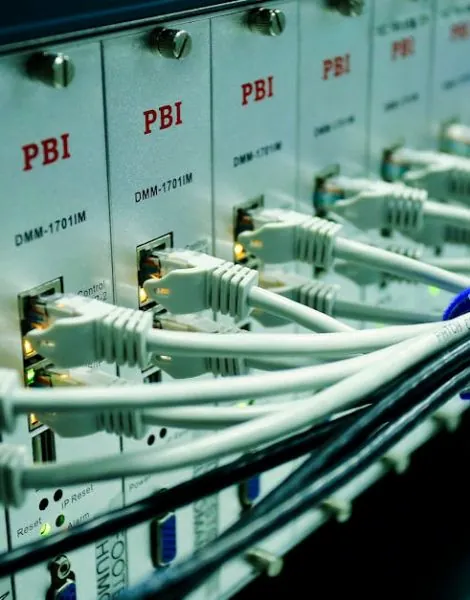In the bustling world of networking, the unsung hero often goes unnoticed: the network patch panel. This nifty gadget is like the backstage crew of a rock concert, ensuring everything runs smoothly while the spotlight shines on other components. Without it, chaos reigns in the data jungle, and no one wants to be the person trying to untangle a mess of cables while their coworkers sip coffee and watch.
Table of Contents
ToggleOverview Of Network Patch Panel
A network patch panel serves as a centralized point for managing network cables. It allows for organized cable connections, minimizing clutter in data environments. Cables connect to ports on the front, while the back provides access to networking equipment such as switches and routers.
Patch panels come in various configurations. Common options include 24-port, 48-port, and 96-port versions, suited for different networking needs. Each port is typically labeled for easy identification, streamlining troubleshooting and setup. Many businesses prefer patch panels because they facilitate quick network changes without affecting the entire system.
Installation of a patch panel enhances network reliability. It allows technicians to reroute connections without physically accessing cables in difficult spaces. In addition, a well-organized patch panel aids in maintaining a clean and efficient workspace.
Types of patch panels exist to cater to specific requirements. Ethernet patch panels, for instance, focus on standard network cables, while fiber optic patch panels support fiber connections, offering higher speed and bandwidth capabilities. Teams often review both types based on their infrastructure needs.
Managing cables with a patch panel helps prevent disruptions. By centralizing connections, minimizing cable tangling becomes easier. Regular checks and maintenance of a patch panel ensure optimal performance, allowing quick identification of faults or issues.
Overall, the network patch panel plays a pivotal role in effective network management. It enhances structure, increases efficiency, and significantly reduces the likelihood of network outages. Investing in a quality patch panel benefits both current and future networking demands.
Types Of Network Patch Panels
Several types of network patch panels suit different networking needs. Each type offers specific features, optimizing the management and organization of network cabling.
Unshielded Twisted Pair (UTP) Patch Panels
Unshielded twisted pair patch panels cater to standard Ethernet networks. Typically designed for home or office environments, they use pairs of wires twisted together to reduce interference. These panels come in various port options, such as 24, 48, or 96 ports, providing flexibility for different scales of installations. Often labeled for easy identification, UTP patch panels streamline connectivity. Technicians prefer UTP panels for cost-effectiveness and ease of installation. Users typically find them reliable for gigabit Ethernet performance and general data transmission.
Shielded Twisted Pair (STP) Patch Panels
Shielded twisted pair patch panels provide enhanced protection against electromagnetic interference. They feature a conductive shield around the wires, making them suitable for environments with high interference, such as industrial settings. STP patch panels are available in similar port configurations as UTP panels, yet they tend to be pricier due to their advanced shielding. These panels help maintain data integrity, especially over longer distances. For networks prioritizing performance and stability, STP panels offer superior options. Users often choose STP for applications requiring higher security and reliable data transmission.
Benefits Of Using Network Patch Panels
Network patch panels offer significant advantages in organizing and managing cables within an infrastructure. They simplify the connection process while enhancing overall network reliability.
Organization And Management
Effective organization of cables becomes achievable with patch panels. Technicians benefit from the structured layout, which reduces clutter in equipment racks. Each port on the front connects clearly to corresponding cables at the back, facilitating easy identification of connections. Labeling options available help streamline troubleshooting efforts. Regular maintenance checks paired with this organization prevent network disruptions. Technicians can quickly access individual cables without navigating a labyrinth of wires, promoting efficiency in data management.
Scalability And Flexibility
Scalability is a crucial benefit of network patch panels. They allow for easy expansion, accommodating growing networks without significant disruptions. Adding new connections becomes seamless, as existing setups can integrate additional ports. Flexibility of configurations enables adaptation to various environments, from home offices to larger corporate networks. The ability to mix and match panels, like using both UTP and STP, adds versatility to the overall network design. This adaptability ensures the network remains reliable and future-proof, addressing evolving technology needs.
Installation And Configuration
Installing and configuring a network patch panel requires careful planning and the right tools. The process enhances network organization and efficiency.
Tools Needed
Technicians need specific tools for installation. A screwdriver, typically Phillips head, secures the patch panel to a rack. Cable testers ensure connectivity and help troubleshoot issues. Wire strippers strip insulation from cables, allowing for clean connections. Punch down tools are necessary for terminating cables securely onto the patch panel. Additionally, label makers assist in accurately identifying ports for easy management.
Step-By-Step Guide
Start by choosing an appropriate location for the patch panel. Install the patch panel in a rack, ensuring it’s level and secure. Next, run cables from network devices to the rear of the patch panel. Use a punch down tool to terminate each cable neatly into its corresponding slot. Afterward, connect the front ports to network switches using patch cables. Test each connection with a cable tester to confirm function. Finally, label each port clearly to enhance future maintenance and modifications.
Common Issues And Troubleshooting
Network patch panels can encounter various issues that may disrupt connectivity and performance. Identifying these problems quickly ensures efficient resolution and restores network functionality.
Connectivity Problems
Connectivity problems in a network patch panel often stem from loose or improperly terminated cables. Inspecting connections can reveal whether cables have been pushed into the ports correctly. Faulty cables can also lead to connectivity issues; replacing any damaged cables usually resolves the problem. A network cable tester can assist in diagnosing wiring faults or breaks. Ensuring proper labeling on ports helps technicians trace problems swiftly.
Signal Loss
Signal loss is another common issue that can occur with patch panel setups. Excessive cable length often contributes to decreased signal quality. Adhering to industry standards for cable lengths aids in reducing potential signal degradation. Furthermore, using patch panels designed for specific cable types—such as UTP or STP—ensures optimal performance and minimizes interference. Regular maintenance, such as checking the integrity of connections and cables, significantly reduces the risk of signal loss during operation.
A network patch panel is essential for maintaining an efficient and organized network environment. By centralizing cable management it reduces clutter and simplifies troubleshooting. This vital component not only enhances reliability but also supports scalability as networks grow.
Investing in the right patch panel tailored to specific needs can make a significant difference in performance. Whether opting for UTP or STP panels professionals can ensure that their networks remain robust and future-proof. Regular maintenance and proper installation practices further contribute to optimal network functionality.
Ultimately a well-implemented patch panel system leads to smoother operations and minimizes the risk of connectivity issues. Embracing this often-overlooked tool is a step toward achieving a high-performing network.









